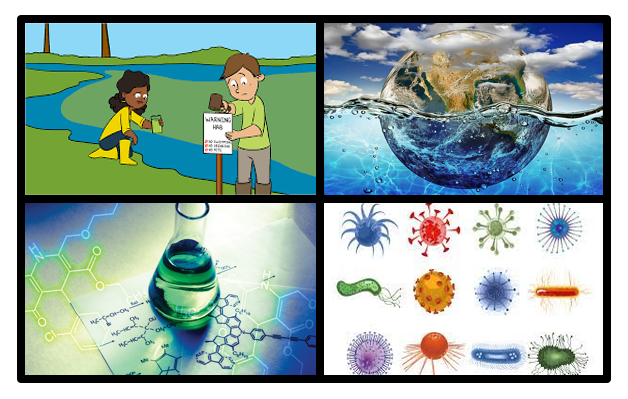Project Description
Dinoflagellates and diatoms such as Alexandrium spp., Dinophysis spp. and Pseudonitzschia spp are widely distributed bloom-forming marine micro-algae. These organisms can produce potent toxins which cause different shellfish poisoning syndromes. Human exposure to these toxins is potentially deadly and occurs via the consumption of toxin-exposed filter-feeding shellfish. Understanding the factors which contribute to the formation of algal blooms and toxin production and identification of the genetic and environmental key drivers is of environmental, economic, and clinical importance. For example the dinoflagellate Alexandrium spp. contains a number of toxic as well as non-toxic species. The genetic and environmental factors inducing toxin production are not well understood. Due to the unusual complexity and size of dinoflagellate genomes, there are limited genome sequencing projects for these organisms, and transcriptome sequencing has become the major focus in this field.
However, a serious limitation is our incomplete understanding of genetic and metabolic network regulation in harmful algae species. Dinoflagellates have a well-developed metabolism to survive even under extreme stress conditions in which gene silencing mechanisms have been reported to be involved in modulating metabolic responses to environmental stress. In particular, microRNAs (miRNAs), a class of endogenous non‐coding RNAs, play an essential role in post‐transcriptional gene regulation in plants, animals and dinoflagellates. These are key factors in stress response molecular pathways triggering cellular responses and metabolic adjustments to stress conditions that affect toxin production. The project proposes to identify and characterize marine algal blooms for example Alexandrium spp. RNAs and proteins and metabolite‐mediated responses to different stress conditions on the toxin production procedures. Both toxin-producing and non-toxin-producing species will be compared. The data will be analyzed to detect the major cascades triggered when the organism faces toxin-inducing environmental conditions.
The project will involve the information transfer from these procedures for the design and production of a prototype diagnostic kit for the detection of the toxin genes specific to the species. Molecular probes are being applied to distinguish species-specific RNA and DNA sequences for the rapid identification of toxins produced by organisms. The direction of this new technology is to develop rapid reliable screening methods for phycotoxins and the causative organisms to protect public health, aquaculture, and natural resources. An innovative sample preparation for toxin detection will be designed so that the device can be used in field. To date a novel method that can be applied on-site and by non-educated farm owners is needed to accurately detect the harmful algae and toxin as an early warning monitoring device. Such a kit must be financially affordable so that it can be used by farm owners.
This can be undertaken using a two-fold approach: Developing a sample preparation method away from the device but where no laboratory equipment is required and secondly the utilization of specific reagents particular for metabolite or nucleic acid amplification that can be built into a cartridge to provide a significant level of detection for both species and toxin analysis. The system will be evaluated for culture analysis using cultures and real samples.
CANDIDATE BACKGROUND
Essential skills: Applicants should have a primary degree (1st or 2.1) in an appropriate discipline (e.g., Genetics, Molecular biology, Biochemistry, Environmental Science). Some experience of PCR – bioinformatics – metabolomics – Transcriptomics
Desirable skills: M.Sc. in an appropriate discipline e.g., Molecular biology, Biochemistry, Environmental Science, Biotechnology. Some practical experience in bioanalytical analysis
Image credit: Katrina Campbell, QUB
Supervisors
Katrina CampbellPrimary Supervisor: | Profile: Katrina Campbell Email: katrina.campbell@qub.ac.uk Institution: Queen's University, Belfast Department/School: School of Biological Sciences |
Frithjof KuepperSecondary Supervisor: | Profile: Frithjof Kuepper Email: fkuepper@abdn.ac.uk Institution: University of Aberdeen Department/School: School of Biological Sciences |
References
Ho KC, Lee TCH, Kwok OT and Lee FWF. (2012). Phylogenetic analysis on a strain of Alexandrium tamarense collected from Antarctic Ocean. Harmful Algae, 15: 100-108.
Cusick K and Sayler G S. (2013). An overview on the marine neurotoxin, saxitoxin: Genetics, molecular targets, methods of detection and ecological functions. Marine drugs, 11(4): 991-1018.
McLean TI. (2013). “Eco-omics”: A Review of the Application of Genomics, Transcriptomics, and Proteomics for the Study of the Ecology of Harmful Algae. Microbial ecology, 65: 901-915.
QUADRAT Themes
- environmental-management
Partners
To be confirmed






















































